
Do you see the WHOLE
PICTURE?
Or
Take off those brontosaurus glasses.
This page is brought to you by by Neil Slade's Amazing Brain Adventure
|
INTRODUCTION:
You may be a creative thinker who stumbles upon a discovery that others, including the so-called "experts", have not yet found. Be prepared. The creative limitations of GROUP THINK is a sad thing, and it often will appear the moment you make a discovery. It's always good to rationally weigh the opinions of others- but if your discovery is truly something extraordinary, you've tested all the possibilities, weighed the implications, and looked for the holes in your idea-- yet it still works......... If it goes against the grain of conventional wisdom-- those with limited imagination, and ego driven bias--- they will knock you down, tell you "it can't work", and do everything in their power to make sure you fail.
Forget them. Onward.
I recently made a discovery about the application of video editing software that went outside the boundaries of conventional wisdom and the recommended settings by the software manufacturer. It had to do with the way "widescreen" video is displayed on a standard TV, specifically video shot using "simulated" widescreen footage called LETTERBOX. My camera is a superb Panasonic DVX100 MiniDV Camera, and I use an excellent software called Sony Vegas, and the latest version as well. When I discovered that there were no drawbacks or negative sides to my discovery in my particular scenario and application, I first called the manufacturer and had a discussion with them about the matter. They listened carefully, had no objection, and in fact were very interested in what I had come upon, and what I had to say. I was then VERY EXCITED and enthusiastic about this new way of using the video software program, and I then proceeded to announce my discovery on a couple of web forums, where people discussed this software, and how it was used.
There, it was met with disbelief, outright refusal, countered with wrong facts and poor observation, as well as cynicism to the degree I have rarely seen on any legitimate web site. It even got to the point where the thread of discussion was closed by the moderator. This occurred every time I posted this information. So threatening was my discovery.
The mere idea that somebody had another way of doing things- this caused a complete cessation of reasonable brain function on the part of numerous individuals. It will happen to you too.
Bear in mind, that I have been a photographer my entire life. I make my entire living from my own books, CDs, and photography (all intertwined). I have been making film and video for 37 years.
When somebody makes such a discovery and tells you, be open and receptive. Think carefully. Don't assume you know everything there is to know. Otherwise, you will always be playing catch up to the pioneers. Don't be a dinosaur, ripe for extinction.
When you make such a discovery yourself one day, just go on, use it, and leave the non-thinkers on display in the Jurassic hall of the museum.
|
Two months ago I began editing a feature film that we shot using the Panasonic DVX100 camera, using Vegas 6.0. Everything was going well UNTIL---
I noted that I was losing information on the sides of my finished edited image, when transferred to DVD and shown on an external standard TV monitor, or just while editing and looking at the external monitor.

My letterboxed image looked too tall compared to 4:3 commercial letterboxed movies, and I noticed this when watching Fellini's 8/12, City of Women, and other widescreen letterboxed films. (Granted aspect ratio differs from film to film, but my letterboxed rendered DVX/Vegas video was hardly close. It was more like chopped 4:3. This was on ANY standard TV, and even my excellent new Sony WEGA- which is excellent for grabbing as much of the frame as any brand.
I was missing A LOT of the image on the sides- hidden in the so called "safe" area, and not showing up in the edges of the TV tube.
The Fellini films, and practically all other 4:3 letterboxed video I was looking at, looked a lot more like widescreen than what I was getting, EVEN THOUGH I WAS FOLLOWING ALL THE RECOMMENDATIONS of VEGAS and the VEGAS DVX100 Whitepaper.
Please note, I am a loyal and enthusiastic user of Vegas, and have been for years. It is an amazingly well thought out editing tool.
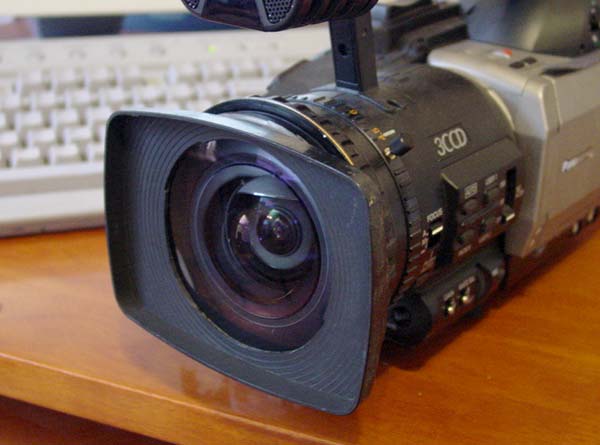
My homemade $100 semi-fisheye lens for my DVX. See links at bottom...
ANYWAY, like any good unsatisfied Thomas Edison wannabe, I began experimenting.
I'll tell you what I discovered-- something NOBODY at Sony Vegas was talking about in any of their literature, forums, or manuals, nor could I find anybody else talking about it ANYWHERE on the web.
When I posted the discovery at now two different DV forums, people even began ARGUING with me telling me I was crazy.
I am not.
I in fact have over 35 years professional photo experience under my belt. And I make my ENTIRE living from my books, music, photos, and now film projects.
I obviously touched an oversensitive ego driven part of their (various DV forum members) psyche that refused to believe that there actually may be another way of doing things that works, something they had not thought of themselves, something even the writers of the software had not addressed completely.
This is as much about the stubborn refusal to honestly look at alternative solutions as anything. It's about what drove the Vatican to put Galileo under arrest because he insisted that the earth was not the center of the universe.
And so, the pictures below are worth a thousand words on people who cannot think outside the box. Forgive them, for they do not know how to click their amygdala forward.
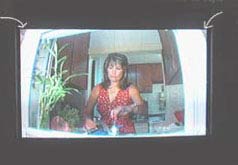
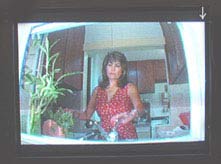
I show the EXACT same footage, in one case using the recommended settings and in the other, my settings.
Son of a gun---- I solved several problems at once. Not only does my letterbox look like real widescreen, as I expect it to, and like well done commercial letterboxed films, but I also don't have to reset my preview window to "simulate" aspect ratio.
FURTHER, and this is most important, while editing-- I SEE EVERYTHING IN MY EXTERNAL MONITOR out to the edges. If you don't, and you edit your film, and then eventual transfer to film, or show when the entire image can be seen- such as MiniDV projection-- stuff you never knew was in the picture will suddenly show up, like boom poles and objects you missed.
It is, in fact, easy to regain every bit of image normally found OUTSIDE THE SAFE AREA BOX, and your final project renders this correctly to DVD, and you get REAL WIDESCREEN as your camera shot (in letterbox mode), not half-assed letterbox.


Of course, as soon as you come up with a useful new suggestion, vultures are waiting in the wings to tear you apart. As soon as I posted this useful bit of out-of-the-box thinking, and non-conformist use of the software, defenders of dead end conformity attacked the method, with totally bogus claims of distortion of the image, loss of resolution in the image, etc.
This is the R-complex portion of the human brain rearing its ugly counter-evolutionary head. Its the part of the brain Dr. Paul McLean coined the term, REPTILE BRAIN: "Just attack everything new first. Understand later, in your sleep, if at all. New things are a THREAT, counter-attack!@!"
And-
If you can't click your amygdala forward out of your reptile brain, you will become like an extinct dinosaur, emotionally and creatively- maybe not today--- but in time, assuredly.
Such counter-claims in this particular issue are for the most part solid crapola. This reveals much about human nature and the resistance to new ideas. We all know the standard method, and that it works to an extent. This is a NEW IDEA. Hello? Anybody home?
The obvious was immediately open to confirmation by simply repeating my observations on any similar system.
Really, it's like people insisting the earth is FLAT, or that the earth is the center of the universe. The Vatican put Galileo under arrest for thinking outside the box.
When I then pointed out all my hard evidence and answers to every single doubtful question, the forum nay-sayers then switched tactics, and claimed I was being "rude", and went on to make further personal attacks that were totally irrelevant to the issue at hand, and that I didn't deserve to be on their forum. Oh good grief, Charlie Brown.....
None the less-
|
This image of the yellow square, when seen on my external monitor measured 6" X 6" EXACTLY on my external Sony monitor in .standard settings.
This image of the yellow square ,
when seen on my external monitor measured 5.5"
X 5.5" exactly in in my discovered
settings.
READ- I MEASURED WITH A FINE RULER ON THE TV SCREEN SURFACE. No tricks on my eyes. I verified with a fine ruler measurement everything that my 20/20 vision was already telling me.
|
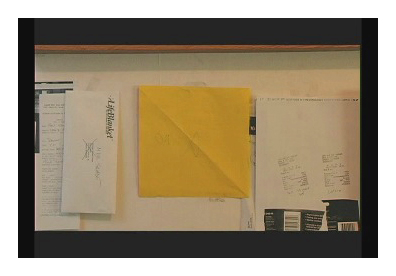

LOOK AT THE KITCHEN CABINETS IN THE BACK- RECTANGLES-- THE PROPORTIONS ARE THE SAME IN EACH, THE IMAGE IS NOT NOT NOT SQUASHED.

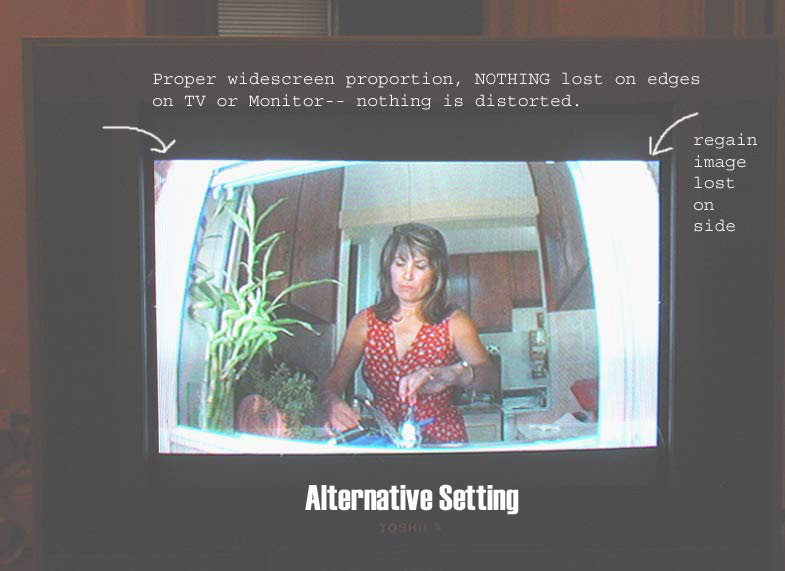
You can't directly compare the sharpness of the two on a TV- because since the alternative discovery image is slightly smaller, you will of course see a microscopic bit more detail in the standard image, since its zoomed in bigger. But from the viewer's point of view sitting a few feet away from the TV set, no difference in sharpness-- the biggest change will be in the shape of the letterbox image, and restoration of the lost image outside in the safe zone, a more significant perceptual improvement in my opinion.
And as anybody with an hour's worth of practical photo experience will know, when you shrink an image THE PERCEPTION IS THAT IT BECOMES SHARPER anyway.
The idea that resolution is lost in lost in this little bit of downsizing is TOTALLY an academic argument, and it means nothing in this application. Even if you could see a loss of detail, you would need a microscope to see it, and on a CRT standard TV at 500 lines interlaced resolution, you will NEVER see it.
What else does the human brain miss?
You would be surprised.... :-)
Below, normal 4:3 aspect, same thing applies.
This is a picture RIGHT OFF A TV MONITOR Note the hidden safe area objects squeezed into the frame by the ualternative settings on the edge of the picture.
Note, again PROPORTIONS REMAIN EXACTLY THE SAME, quite obvious here because of the checkerboard pattern.
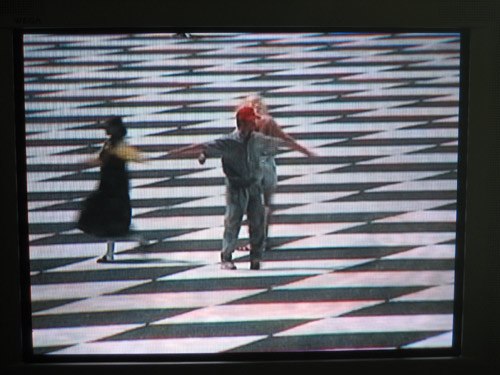
This does not dismiss the idea of the safe area, generally a useful guide, but the implications of being chained to having a safe area loses most meaning when you are utilizing widescreen or letterbox on a 4:3 standard TV set, and you've already got big ass black bars on the top and bottom of the picture.
If you have a DVX100, and perhaps other cameras, and shoot letterbox, I hope you can handle this idea outside the box. It will be good for your brain health, and likely your movies too.
|
DETAILS:
Widescreen Simulation & Letterbox Sony Vegas and the Panasonic DVX100 (and perhaps all other letterboxed video) This is both a brain tale, and a video tale.....
|